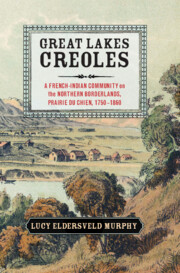Great Lakes Creoles A French-Indian Community on the Northern Borderlands, Prairie du Chien, 1750-1860 by Lucy Eldersveld Murphy (review)
Ohio Valley History
Volume 16, Number 1, Spring 2016
pages 81-83
Margo Lambert, Assistant Professor of History
Blue Ash College, University of Cinicinnati
Lucy Eldersveld Murphy. Great Lakes Creoles: A French-Indian Community on the Northern Borderlands, Prairie du Chien, 1750-1860. New York: Cambridge University Press, 2014. 326 pp. 25 b/w illus. 6 maps. 7 tables. ISBN: 9781107052864 (cloth), $94.99; 9781107674745 (paper), $34.99
Lucy Murphy adroitly focuses her lens on the complex tale of Prairie du Chien, Wisconsin, a community peopled by Native Americans, French-Canadian fur traders, British soldiers, and eventually Americans (and even a few African Americans) after the American Revolution. Europeans first entered the native world slowly, inter-marrying and establishing a multi-ethnic Creole community only to face further change when Anglo-Americans took control and eventually became the community’s majority. For Native American historians (and others) looking for a deeper glimpse into this world, Murphy’s probing analysis of the mixed multitudes of one small fur-trading community delivers. And, if that were not enough, Murphy adds another layer to her study: she compares this borderland to that of the American Southwest after the Mexican-American War—where the community’s pioneers became the political minority—and to that of the Métis culture that developed on the western Canadian border in the late nineteenth-century—there probing why that culture developed a clear indigenous ancestry, whereas south of the border in the Great Lakes area a similar culture never arose.
Murphy begins in the 1750s, tracing the community’s transition from Native American Meskwaki village to fur-trade enclave. By the early nineteenth-century the Meskwakis had relocated, although some remained behind, having intertwined their lives with European-descended fur traders and borne them children. With the establishment of the Northwest Ordinance of 1787 and the final showdown of the War of 1812, the United States government began to assert its control of the town. Government officials courted the Creole community they found there, recognizing Creole support would only aid United States’ control, legitimizing America’s domination and opening of the West to Anglo-American settlers. The most vital point, Murphy argues here, was that this courtship prompted the United States government to identify the Creole community as white.
Next, Murphy assesses the shifting political structure as Prairie du Chien came under United States’ control. Because of the region’s multi-ethnicity, U.S. officials—as a minority—had to tread carefully, identifying Creoles as white, evidenced by their voting and serving on juries. Native Americans were deliberately left out of this process, but even Creoles with Metis status and Metis wives still fell into the white political categorization. Murphy shows that Creoles exerted much agency politically in the early days, defending themselves against what they deemed inappropriate newcomer behaviors that did not mesh with their established ways. As American control solidified and relegated Creoles to minority status, the town’s Creoles managed to hold some strength within the new legal system, despite their mixed-race realities. However, the rising Anglo tide reduced Creole influence considerably by the 1830s. But Creoles’ “white status” labelled them to identify culturally rather than racially: as French, rather than Métis. Here was why most mixed Native American groups south of the border diverged from their northwestern neighbors in Canada.
Perhaps one of Murphy’s most striking contributions to Native American studies is her work on gender. The chapter “Public Mothers” describes a different gender world denied to Anglo women but open to the town’s Creoles. Many of the town’s Creole women managed to position themselves as cultural mediators, explaining Creole and Native ways to incoming Euro-Americans, especially via marriage, adoption, and traditional gender roles in areas of charity, hospitality, midwifery, and the like. Whereas Creole men were increasingly denied a political voice as American numbers rose, Creole women managed to meet on a middle ground with American women. They served as public mothers, Murphy asserts, mediating between the various ethnic groups and succeeding in connecting Creoles, Native Americans, African Americans, and Euro-Americans by shared women’s activities that aided both private and public spheres, the latter sought by traditional “female” activities noted above. Their mediation, Murphy argues, further solidified Creoles as “whites” in the…


